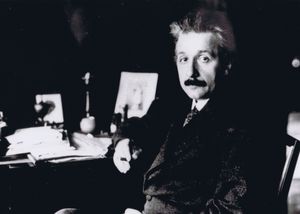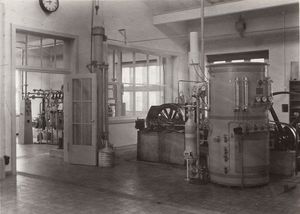Einstein's annus mirabilis
In 2005, all over the world Albert Einstein and his ground-breaking work from the year 1905, with which he revolutionized physics, were commemorated. In this "annus mirabilis" Einstein, an unknown 26-year old physicist, restated the concepts of space and time by publishing the basics of special relativity (and postulated the equivalence of energy and matter E=mc2 in an annotation to the same work), introduced the quantum nature of light as the explanation for the photoelectric effect (this work is mentioned in the explanatory statement for his 1921 Nobel prize), made an atomistic interpretation of Brownian motion and described a method for measuring molecule dimensions in his doctoral thesis.
Einstein, KWI and MPI
The Max-Planck-Institut für Physik (Werner-Heisenberg-Institut) in Munich derived from the Kaiser-Wilhelm-Institut für Physik (KWI), which was founded on October 1st, 1917 in Berlin, with Albert Einstein as its first director. Albert Einstein had in 1915 completed the theory of general relativity there, formulated the theory of absorption and stimulated emission of light quanta - which became the foundation of laser theory - in 1916 and investigated the statistical behaviour of so-called Bose particles and predicted their condensation in the years 1924-25. The latter could be experimentally proved 70 years later. Up to his death Einstein tried intensely but without success to find a unified theory of all physical forces.
Major research work by, among others, Otto Stern and Walter Gerlach, Willy Wien, Lise Meitner and Max Born was funded by the Kaiser-Wilhelm-Institut für Physik, which, until 1938, had no building of its own. After the aquisition of power by the national socialists and beginning hostilities in Germany, Albert Einstein did not return from a visit to the United States and emigrated there. His deputy Max von Laue became the interim director of the institute. 1936 Dutch Peter Debye was appointed to the new institute that had in the meantime been built in Berlin-Dahlem with american funding. Only shortly after, in 1940, after the institute had been put under command of the army ordnance department, Debye emigrated to the USA as well. 1942 the institute was reincorporated into the Kaiser-Wilhelm-Gesellschaft und Werner Heisenberg created director. In 1946 the institute, lead by Werner Heisenberg, started work as the Max-Planck-Institut für Physik in Göttingen and was relocated to Munich in 1958. Later it split up into the Max-Planck-Institut für Physik (Werner-Heisenberg-Institut) and those for plasma physics, astrophysics und for extraterrestrial physics.
(Prof. Dr. Gerd Buschhorn)

